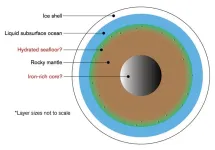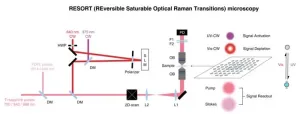University of Montana science unlocks secrets of high-elevation pregnancies
2023-06-17
(Press-News.org) MISSOULA – Pregnancy at high elevations often is associated with low birth weights and other complications. These challenges occur in a wide range of mammals, from deer mice to human beings.
Research conducted at the University of Montana revealed some of the genetic underpinnings that allow certain highland mouse populations to protect developing fetuses in higher areas. The work was published recently in the Proceedings of the National Academy of Sciences.
“Understanding how deer mice survive and thrive at high elevations not only informs our understanding of basic evolutionary processes, it may also one day provide clues for treating a range of related disorders in humans,” said Zac Cheviron, a UM researcher and biology associate professor.
The work was led by Kate Wilsterman, a UM postdoctoral researcher who has since joined the faculty of Colorado State University. Cheviron, UM biology Professor Jeff Good and former UM postdoctoral researcher Rena Schweizer were her chief collaborators in Montana.
Their research shows that fetal growth is adversely affected by decreased oxygen at high elevations in mice that are native to low elevations. Mice native to high elevations, however, have genetic differences that provide placental modifications that protect fetuses from hypoxia, which is lack of oxygen to the fetus. This pattern is similar to that observed in humans, such as people of Tibetan or Andean ancestry. These human populations also protect fetal growth at high elevation, but researchers have little understanding of how it is achieved.
Cheviron said one of the most exciting aspects of their work was the discovery that many genes that seem to target fetal growth in their study species – highland deer mice – also have been associated with placental physiology in people.
“This suggests that the genetic and physiological mechanisms that underlie healthy pregnancies at high elevation may have deep evolutionary roots,” he said. “We might be able to use this insight to develop new treatments to improve pregnancy outcomes in humans.”
During the study, lowland mice experienced stunted fetal growth in hypoxia conditions, but highland mice avoided negative effects by altering their placentas.
“If we can understand how deer mice have ‘solved’ the problem of hypoxia for fetal growth,” Wilsterman said, “we may eventually be able to identify targets for treatment development in humans or be in a better position to identify where things are going wrong in gestational diseases that involve hypoxia.”
She said future studies will examine the tissue-level changes they discovered among deer mice. They also hope to identify the genetic variants that contribute to how specific cell types respond to hypoxia.
###
END
[Attachments] See images for this press release:

ELSE PRESS RELEASES FROM THIS DATE:
2023-06-16
Jupiter's moon, Europa, is slightly smaller than Earth’s Moon and is one of the most promising places to search for alien life.
Amid the Jovian system, Europa is of particular interest to scientists because of the strong evidence for nutrients, water and energy to potentially provide a habitable environment for some form of life beyond Earth. In addition, Europa is believed to be made up into four layers (from surface to center): an ice shell, salt water ocean, rocky mantle, and metallic core.
Like Earth, Europa’s ...
2023-06-16
HOUSTON ― Researchers from The University of Texas MD Anderson Cancer Center found the KRAS G12C inhibitor adagrasib showed promising activity suppressing cancer growth not only within the lungs but also in brain metastases for patients with KRAS G12C-mutated non-small cell lung cancer (NSCLC).
Findings from the Phase Ib cohort of the KRYSTAL-1 trial, published today in the Journal of Clinical Oncology, represent the first prospective data of anti-tumor activity from a KRAS G12C inhibitor in brain metastases, providing continued evidence of the ...
2023-06-16
Virginia Tech researchers with the Fralin Biomedical Research Institute at VTC have demonstrated that children with a wide range of diagnoses that affect their motor function improve after receiving intensive pediatric neurorehabilitation called ACQUIRE Therapy.
The findings were published in June in Behavioral Sciences and will be included in an upcoming special issue of the journal devoted to “shifting the therapeutic paradigm for children with neuromotor disabilities to maximize development.”
“We ...
2023-06-16
As a part of its life cycle, the human immunodeficiency virus-1 (HIV) inserts a copy of its DNA into human immune cells. Some of these newly infected immune cells can then transition into a dormant, latent state for a long period of time, which is referred to as HIV latency.
Although current therapies, such current antiretroviral therapy (ART), can successfully block the virus from replicating further, it cannot eradicate latent HIV. If treatment is ever discontinued, the virus can rebound from latency and reignite the progression of HIV infection to AIDS.
Scientists from the HIV Cure Center at the UNC School of Medicine, University of California ...
2023-06-16
Cancer cells are even smarter than scientists previously believed, according to new CU Boulder research. When these cells are confronted with potent new drugs called CDK2 inhibitors, which are designed to prevent cancer from proliferating, they can trigger a workaround to survive the assault in as little as one to two hours.
But the study, published June 8 in the journal “Cell,” comes with a silver lining.
It reveals how cancer cells complete this adaption and shows that simultaneously administering a second, already widely ...
2023-06-16
Breast cancer is a complex disease, and its progression is difficult, yet important, to predict.
While many elements may contribute to a breast cancer prognosis, University of Massachusetts Amherst biostatistician Chi Hyun Lee has zeroed in on one risk factor that has emerged for its potential to predict the disease’s progression.
Lee will use a two-year, $154,791 grant from the National Institutes of Health (NIH) in an effort to develop statistical tools that will better predict breast cancer survival rates and survival time after breast cancer recurrence.
While the project focuses on breast cancer research, the proposed statistical ...
2023-06-16
NEWPORT NEWS, VA – When the global pandemic put the kibosh on in-person events, the U.S. Department of Energy’s Thomas Jefferson National Accelerator Facility sought alternatives for ensuring its world-class science and unique equipment remained accessible. These efforts culminated in the Fall for Science Virtual Field Trip Event, which rolled out a virtual tour experience, new website, and unique supporting materials. Now, the event has been recognized by the Public Relations Society of America with three Anvil Awards.
According ...
2023-06-16
Cedars-Sinai investigators have identified several steps in a cellular process responsible for triggering one of the body’s important inflammatory responses. Their findings, published in the peer-reviewed journal Science Immunology, open up possibilities for modulating the type of inflammation associated with several infections and inflammatory diseases.
Specifically, the investigators have improved understanding of the steps that lead to the production of IL-1 beta, a potent inflammatory protein signal released during many inflammatory responses.
“We now have a clearer understanding of the stepwise process that leads to the production of IL-1 beta,” said Andrea ...
2023-06-16
There are various ways to image biological samples on a microscopic level, and each has its own pros and cons. For the first time, a team of researchers, including those from the University of Tokyo, has combined aspects from two of the leading imaging techniques to craft a new method of imaging and analyzing biological samples. Its concept, known as RESORT, paves the way to observe living systems in unprecedented detail.
For as long as humanity has been able to manipulate glass, we have used optical devices to peer at the microscopic world in ever increasing ...
2023-06-16
In the cerebral cortex, neurogenesis – the formation of neural cells from stem cells – begins in the fetus from 5 weeks gestation and is almost complete by 28 weeks. It is a complex process with finely tuned mechanisms. “In humans, neurogenesis lasts particularly long compared with other species, explains Khadijeh Shabani, a post-doctoral researcher at Paris Brain Institute. Neural stem cells remain in a progenitor state for an extended period. Only later do they differentiate into glial cells, astrocytes, or oligodendrocytes that will form the architecture of the brain and spinal cord.”
Until ...
LAST 30 PRESS RELEASES:
[Press-News.org] University of Montana science unlocks secrets of high-elevation pregnancies








